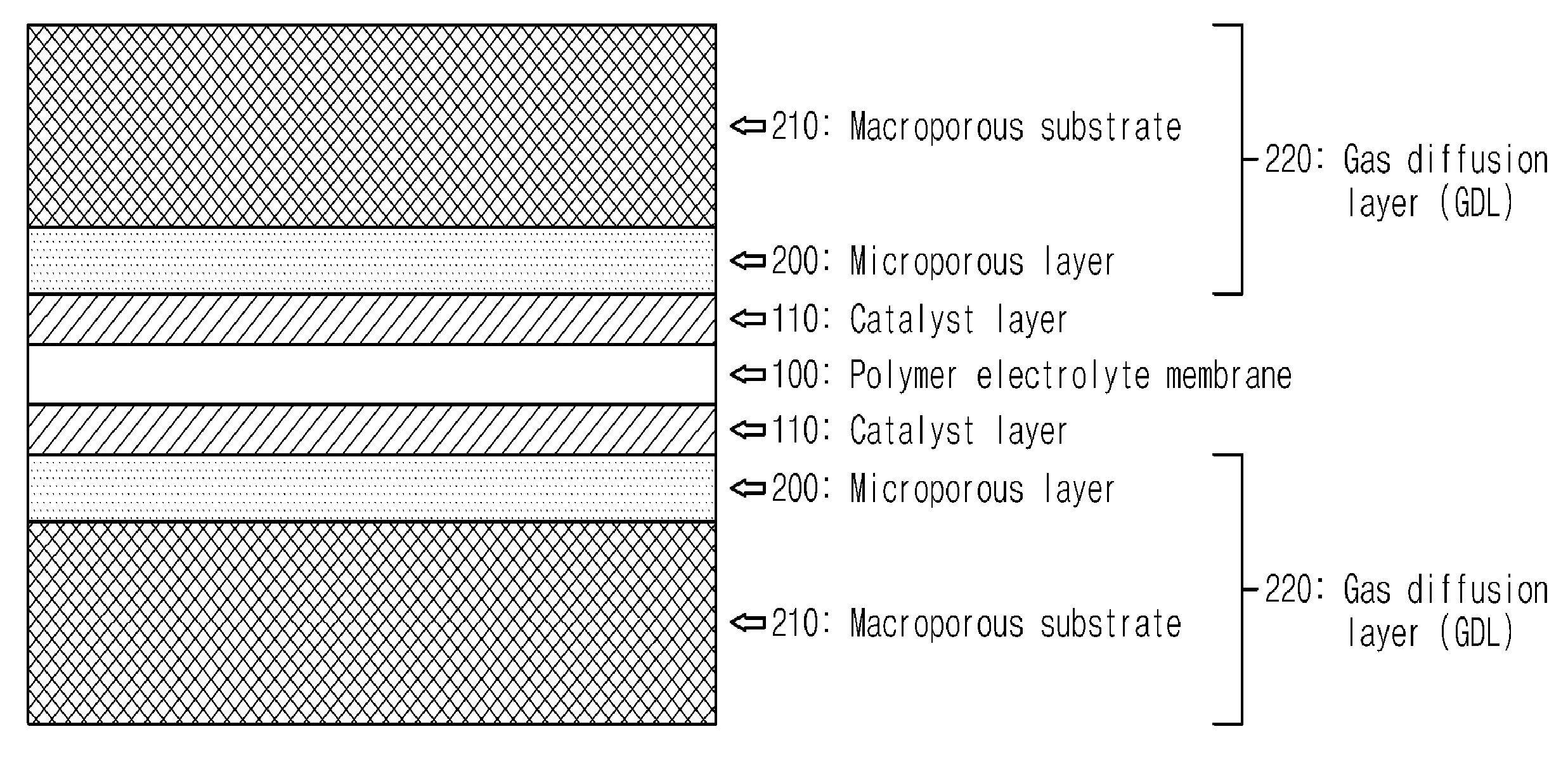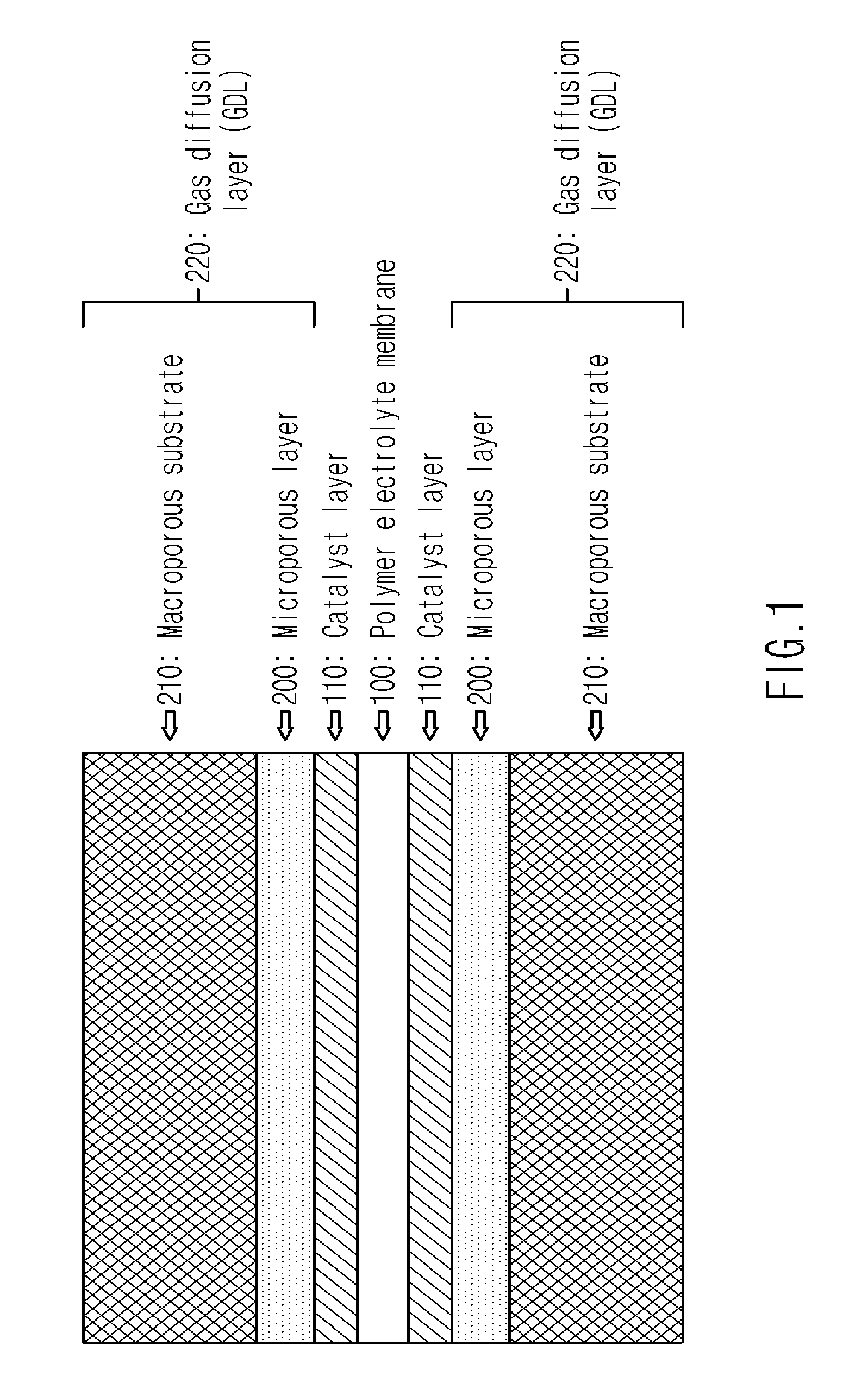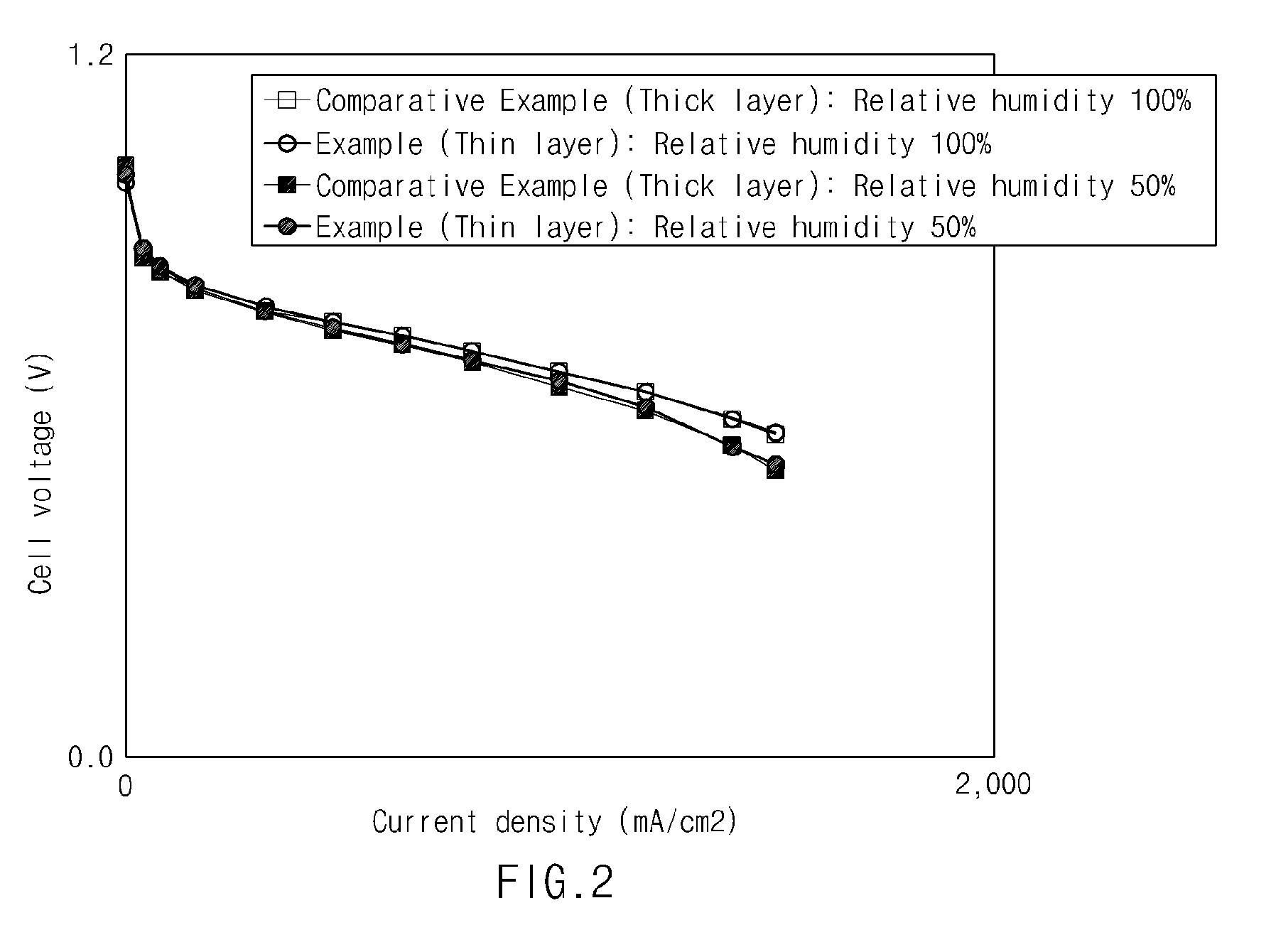Gas Diffusion Layer for Fuel Cell Vehicle with Improved Operational Stability
Active Publication Date: 2010-05-27
HYUNDAI MOTOR CO LTD +1
View PDF3 Cites 27 Cited by
- Summary
- Abstract
- Description
- Claims
- Application Information
AI Technical Summary
Benefits of technology
[0021]The present invention provides a gas diffusion layer for a fuel cell vehicle with improved operational stability, characterized in that the gas diffusion layer is formed with a dual layer structure including a microporous layer and a macroporous substrate, the gas diffusion layer has a thickness of 200 to 300 μm at 25 kPa and a thickness of 170 to 250 μm at 1 MPa, a density of 0.20 to 0.60 g / cm3 at 25 kPa, a porosity of 50 to 90% measured by mercury intrusion, and a through-plane electrical resistance of 30 mΩ·cm2 or lower measured at a clamping pressure of 1 MPa.
Problems solved by technology
On the other hand, if the water is produced excessively and is not appropriately removed, flooding occurs at high current density, preventing the reactant gases from being sufficiently supplied into the fuel cell and thereby increasing voltage loss.
For example, especially when high power is required during operation of the fuel cell vehicle, if the reactant gases are not sufficiently supplied to the fuel cell by the flooding phenomenon, it is difficult for the vehicle to be stably operated.
Meanwhile, since a large number of components are disposed in a limited space of a fuel cell vehicle, it is important that the components are miniaturized.
A conventional gas diffusion layer is difficult to provide a stable operation under abnormal operational conditions such as a shortage in hydrogen supply.
Also, since it is thick, the degree of freedom of vehicle design is affected.
Method used
the structure of the environmentally friendly knitted fabric provided by the present invention; figure 2 Flow chart of the yarn wrapping machine for environmentally friendly knitted fabrics and storage devices; image 3 Is the parameter map of the yarn covering machine
View moreImage
Smart Image Click on the blue labels to locate them in the text.
Smart ImageViewing Examples
Examples
Experimental program
Comparison scheme
Effect test
example
[0040]A carbon fiber felt based gas diffusion layer was prepared by using a conventional method such that the gas diffusion layer has a thickness of 250 μm at a pressure of 25 kPa, a density of 0.40 g / cm3 at a pressure of 25 kPa, a porosity of 70% when measured by mercury intrusion porosimeter, and a through-plane resistance of 10 mΩ·cm2 at 1 MPa.
the structure of the environmentally friendly knitted fabric provided by the present invention; figure 2 Flow chart of the yarn wrapping machine for environmentally friendly knitted fabrics and storage devices; image 3 Is the parameter map of the yarn covering machine
Login to View More PUM
 Login to View More
Login to View More Abstract
The present invention provides a gas diffusion layer for a fuel cell vehicle with improved operational stability, the gas diffusion layer, which functions to supply hydrogen and air (oxygen) as reactant gases to a fuel cell stack, discharge product water generated by an electrochemical reaction, and transmit generated electricity, being formed with a thinned structure.For this purpose, the present invention provides a gas diffusion layer for a fuel cell vehicle with improved operational stability, the gas diffusion layer being formed with a dual layer structure including a microporous layer and a macroporous substrate, the macroporous substrate being formed of a material selected from the group consisting of carbon fiber felt and carbon fiber paper, the gas diffusion layer being thinned to have a thickness of 200 to 300 μm at 25 kPa and a thickness of 170 to 250 μm at 1 MPa, a density of 0.20 to 0.60 g / cm3 at 25 kPa, a porosity of 50 to 90% measured by mercury intrusion, and a through-plane electrical resistance of 30 mΩ·cm2 or lower measured at a clamping pressure of 1 MPa.
Description
CROSS-REFERENCE TO RELATED APPLICATION[0001]This application claims under 35 U.S.C. §119(a) the benefit of Korean Patent Application No. 10-2008-0117247 filed Nov. 25, 2008, the entire contents of which are incorporated herein by reference.BACKGROUND[0002](a) Technical Field[0003]The present disclosure relates to a gas diffusion layer for a fuel cell with improved operational stability.[0004](b) Background Art[0005]One of the electrolyte membrane for use in a fuel cell vehicle is a polymer electrolyte membrane fuel cell (PEMFC). The PEMFC needs to stably operate over a wide current density range such that it may exhibit a high-power performance of at least several tens of kW under various operational conditions of the vehicle [S. Park, J. Lee, and B. N. Popov, J. Power Sources, 177, 457 (2008)].[0006]A fuel cell generates electricity through an electrochemical reaction between hydrogen and oxygen. Hydrogen supplied to an anode (oxidation electrode) of the fuel cell is dissociated in...
Claims
the structure of the environmentally friendly knitted fabric provided by the present invention; figure 2 Flow chart of the yarn wrapping machine for environmentally friendly knitted fabrics and storage devices; image 3 Is the parameter map of the yarn covering machine
Login to View More Application Information
Patent Timeline
 Login to View More
Login to View More IPC IPC(8): H01M2/14
CPCH01M4/8807H01M8/0234Y02E60/50H01M2008/1095H01M8/0245H01M8/02B32B5/22B60L50/50
Inventor HONG, BO KIHAN, KOOK IIAHN, SANG YEOULLEE, KEUN JEJEONG, BYEONG HEON
Owner HYUNDAI MOTOR CO LTD
Features
- R&D
- Intellectual Property
- Life Sciences
- Materials
- Tech Scout
Why Patsnap Eureka
- Unparalleled Data Quality
- Higher Quality Content
- 60% Fewer Hallucinations
Social media
Patsnap Eureka Blog
Learn More Browse by: Latest US Patents, China's latest patents, Technical Efficacy Thesaurus, Application Domain, Technology Topic, Popular Technical Reports.
© 2025 PatSnap. All rights reserved.Legal|Privacy policy|Modern Slavery Act Transparency Statement|Sitemap|About US| Contact US: help@patsnap.com



